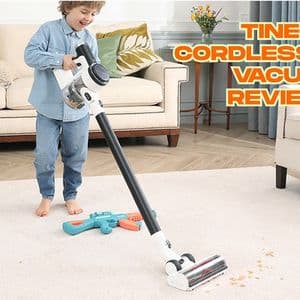Understanding the Different Types of Vacuum Cleaners
Not all vacuums are built the same. Each type is designed to handle different cleaning demands and floor types. Here's a breakdown of the main categories:
Upright Vacuum Cleaners
These are traditional, full-sized models commonly used in households. Uprights typically have a strong motor and wide cleaning head, making them ideal for carpeted areas. They're easy to store, but can be heavier than other options.
Pros:
-
Great suction power
-
Large dustbins
-
Often include attachments
Cons:
-
Heavier to push and carry
-
May not fit well under furniture
Canister Vacuums
A canister vacuum has a separate canister unit connected to the suction head by a hose. This design offers more flexibility for reaching under furniture or cleaning stairs.
Pros:
-
Maneuverable
-
Quiet operation
-
Good for multi-surface cleaning
Cons:
-
Bulky to store
-
Takes more time to set up and move around
Stick Vacuums
These are lightweight and convenient, especially for small spaces or quick cleanups. Stick vacuums are usually battery-powered and designed for easy handling.
Pros:
-
Lightweight and compact
-
Easy to use daily
-
Some convert to handheld units
Cons:
-
Smaller dust capacity
-
Less powerful than upright models
Robot Vacuums
Robot vacuums offer hands-free cleaning by navigating rooms on their own. They’re ideal for maintenance between deep cleans, but may not fully replace traditional models.
Pros:
-
Automatic operation
-
Great for maintenance cleaning
-
Can be scheduled remotely
Cons:
-
Limited suction power
-
May struggle with corners or rugs
Bagged vs. Bagless Vacuums
Another major point in any vacuum cleaners comparison is whether the model is bagged or bagless.
Bagged Vacuums:
These use replaceable bags to collect dirt. They're often better for allergy sufferers because they trap dust more effectively.
Bagless Vacuums:
These use reusable dust bins. They’re more convenient and cost-effective since you don’t need to buy replacement bags.
Corded vs. Cordless Models
Corded vacuums offer constant power, making them suitable for large cleaning sessions. However, they limit your range of movement.
Cordless vacuums offer freedom to move but rely on battery life. They're perfect for quick jobs or small areas, but may fall short during extended use.
Key Factors to Consider in a Vacuum Cleaners Comparison
Let’s dive deeper into what you should compare across different models:
Suction Power
Higher suction power typically means better performance, especially on carpets. Look for models with adjustable suction to handle a variety of surfaces.
Weight and Portability
Heavier models can be harder to carry up stairs or maneuver around furniture. Lightweight options like a stand vacuum cleaner are easier to use daily, especially for people with mobility concerns.
Dustbin or Bag Capacity
Larger capacities mean fewer trips to the trash. If you have pets or a large home, this becomes especially important.
Filtration System
A high-quality filtration system, like HEPA filters, can trap allergens and fine particles. This is a must-have for homes with allergy sufferers.
Noise Level
Some vacuums are much louder than others. If you're sensitive to noise or live in an apartment, consider quieter models like canister or robotic vacuums.
Attachments and Accessories
Brushes, crevice tools, and upholstery attachments can significantly improve a vacuum’s versatility. Check what comes included—and whether extra tools are needed.
Comparing Maintenance and Longevity
Vacuum cleaners aren’t just a one-time purchase—they require ongoing care.
Maintenance Factors to Look For:
-
Filter replacement schedules
-
Battery replacement (for cordless models)
-
Ease of emptying dustbins or replacing bags
-
Brush roll cleaning
Generally, upright and canister models last longer due to their more robust construction. Stick vacuums may require more frequent part replacements.
Read more: Best Dyson Model
Performance on Different Surfaces
You’ll want a vacuum that handles all the floors in your home. Here’s how the different types stack up:
| Surface Type | Best Vacuum Type |
|---|---|
| Hardwood Floors | Canister, Stick |
| Thick Carpet | Upright with strong suction |
| Tile or Linoleum | Stick, Canister |
| Area Rugs | Upright, Stick with attachments |
| Pet Hair | Upright or Stick with motorized brush |
Specialized Needs: Pets, Allergies, and Tight Spaces
Everyone’s cleaning needs are different. Here are a few special considerations:
-
For Pet Owners: Look for strong suction and a motorized brush head to handle hair.
-
For Allergy Sufferers: Choose models with sealed systems and HEPA filters.
-
For Small Homes or Apartments: Compact options like cheap stick vacuum cleaners are easier to store and use without sacrificing convenience.
Budget Considerations
Vacuum cleaners can range from under $100 to over $800. Price often correlates with durability, suction power, and advanced features—but not always.
When comparing models by price, ask yourself:
-
Is it built to last?
-
Will it meet your specific cleaning needs?
-
Is the brand known for reliability and service?
It’s not just about finding the cheapest option—it’s about value. Sometimes a slightly more expensive model can save you money over time through better performance and less maintenance.
Conclusion
Choosing the right vacuum isn’t just about picking a popular model—it’s about matching your cleaning habits, home layout, and specific needs to the right features. A thoughtful vacuum cleaners comparison gives you a clear view of the advantages and limitations of each type, from upright to robot vacuums.
Take stock of your priorities: Do you need something lightweight? Is pet hair a problem? Are you on a tight budget or willing to invest in long-term performance? Whether you're leaning toward a stand vacuum cleaner for its simplicity or browsing cheap stick vacuum cleaners for everyday use, the right choice depends on your personal context.
Ultimately, understanding the different types, key features, and use cases will help you make an informed decision that keeps your floors clean and your life easier.










